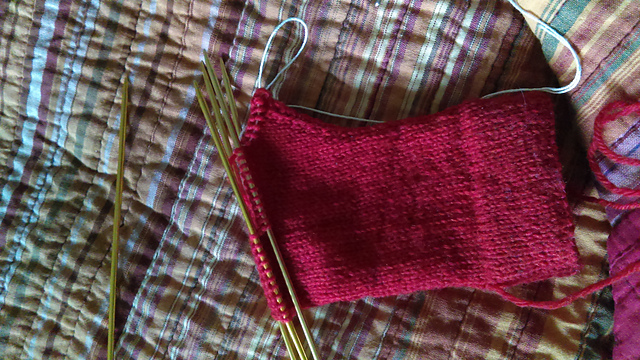I have four inches of cuff now, measured from the turning row on the hem. It's time to start the increases for the thumb gusset (sometimes also called a gore).
A gusset in knitting is a triangle of fabric created to give room for movement or an awkward shape (like a thumb sprouting from the side of a hand or a leg that suddenly makes a right angle and turns into a foot). You find them most commonly after the heel turn on a sock (or before if you started from the toe), under the arm of a sweater, or under the thumb of a mitten or glove.
You can make a thumb opening in a mitten without first making a gusset, and many traditional Scandinavian mittens are made this way, because it doesn't interfere with the colorwork the way suddenly throwing increases in would. The stitches for the thumb, usually 1/4 of the total stitches on the left or right palm, are knit onto waste yarn, and you continue over top of it, then come back after the body of the mitten is finished, take out the waste yarn and put the now-live stitches back on the needle to knit the thumb, or you just knit the entire body of the mitten without stopping, and go back and snip a single stitch in the middle of where you want the thumb to be, unravel half the thumb stitches to the left and half to the right from the snipped stitch, and pick up and knit as for the first method.
There are two reasons I rarely do an afterthought thumb - it doesn't fit as well on my hands, and it creates mittens that are specifically for one hand or the other. You can make offset gussets that are hand-specific, and of course any mitten that has patterning on the back but not the palm will automatically have to be worn on a certain hand or the design won't be on the right side, but particularly in mittens for children, it's nice not to have to stop and figure out which hand goes in which mitten. We already spend too much time doing that with shoes, thank you very much.
So, onto the gusset!
I already know that I need to have 56 stitches by the end of the gusset (see C is for Calculations). I have 44 stitches on the needles now. Between the wrist and the base of the thumb, I therefore need to increase 12 stitches. This distance on my son's hand is about 1.5" and my row gauge is 10.5 rounds/inch. Dividing the distance by the gauge gives me (approximately) 15, which is the number of rounds I have to make my increases in. I could knit a plain round, make a single increase in the next six rounds, make a plain round, do six more increase rounds, and knit a plain round, but the model mitten that I'm working on appears to have its increases paired - two increases per round. That only gives me six increase rounds to work with, so I'll need to find a way to space them evenly into 15 rounds overall. I find it easiest to do this by drawing a picture.
So we can see that after the first increase I'll be increasing every third round. I end up with a total of 16 rounds, but it's close enough.
(After actually working the gusset, the math didn't work out, and the gusset wasn't big enough, so I added an additional two plain rows and increase, which will be reflected in the numbers to follow)
The placement of the increases on the mitten is the next consideration. I mentioned in D is for Decoding the Design that the gusset on the historical mitten is made in an atypical fashion. The increases are placed on either side of a couple stitches, and each subsequent increase is made next to those same stitches, creating, basically, a miter up the side of the mitten, with the newly made stitches growing into the hand of the mitten. Normally, increases start at a single point, and each subsequent increase happens outside of the stitches created before, growing out of the side of the mitten, into the thumb.
The upside to the way we'll be making the mitten is that I won't need to mark where the increases will happen, it will always be before the last stitch of the second needle, and after the first stitch on the third needle. Maybe that's why the original knitter chose to do it that way, or maybe she (or he, perhaps), wasn't paying attention and made the first few increases going the 'wrong' way and just decided to make it a design element, instead of ripping back and starting over. I can get behind that kind of thinking.
So my gusset section will work thusly:
Rounds 1, 4, 7, 10, 13, 16, 19: Knit to the last stitch on second needle, increase, knit last stitch, knit first stitch on third needle, increase, knit to end of round
Rounds 2, 3, 5, 6, 8, 9, 11, 12, 14, 15, 17, 18: Knit
After 19 rounds, there are 7 stitches new stitches on either side of the two stitches that marked my increases.
I knit up to the last 8 stitches on the second needle, then take a darning needle threaded with crochet cotton, and use it to slip those 8 stitches, and the first 8 stitches on the third needle, onto the thread.
This will keep the stitches live and out of the way while I work on the hand, and they'll be ready for me to pick back up when I return to finish the thumb.




No comments:
Post a Comment